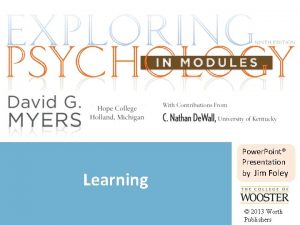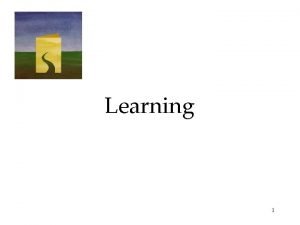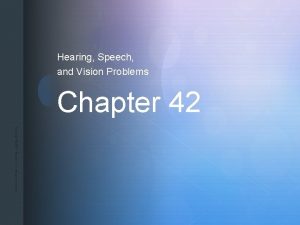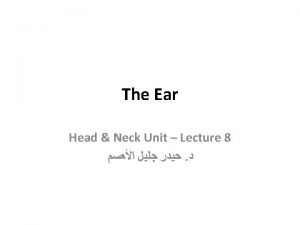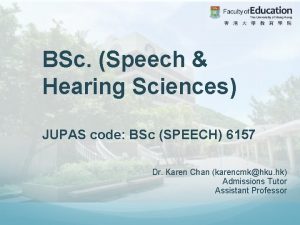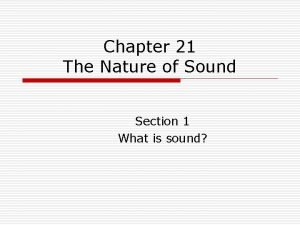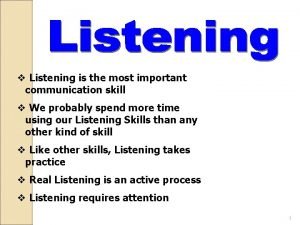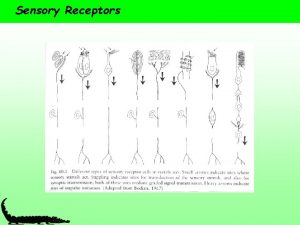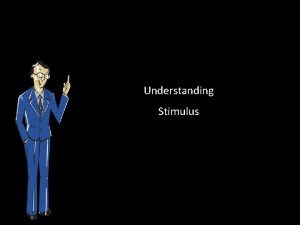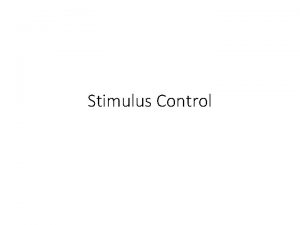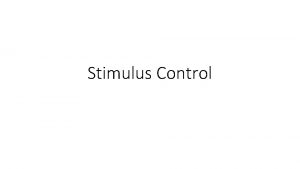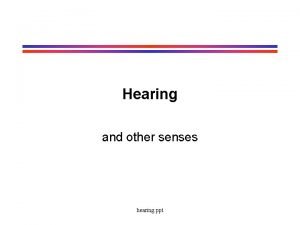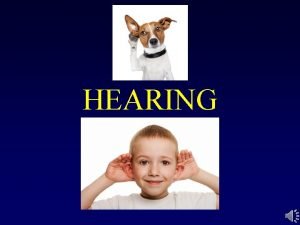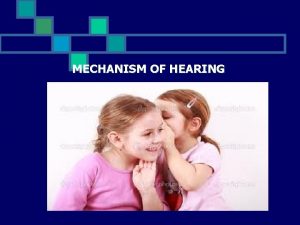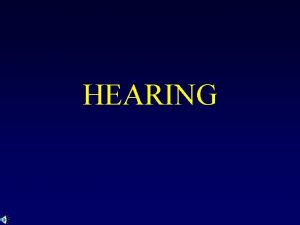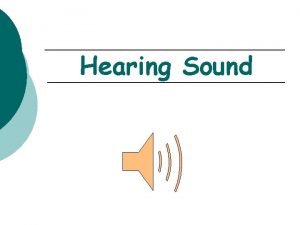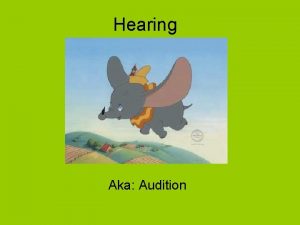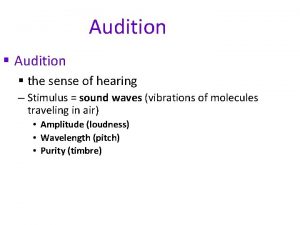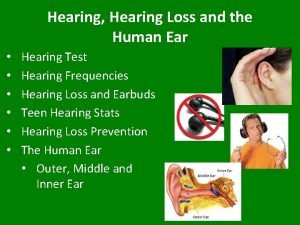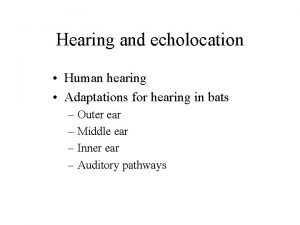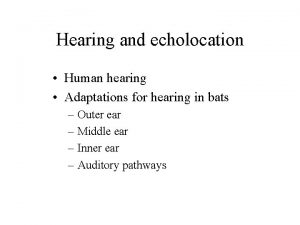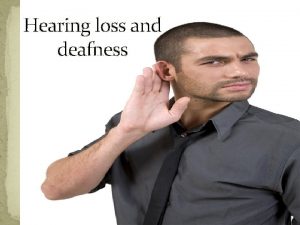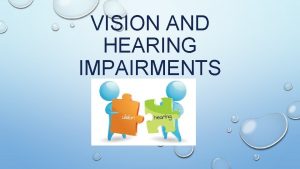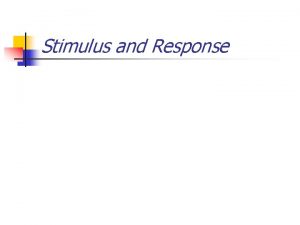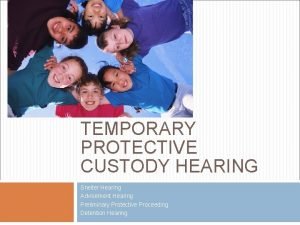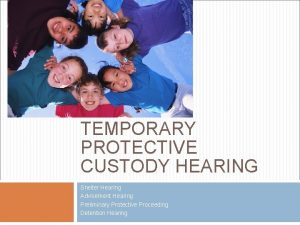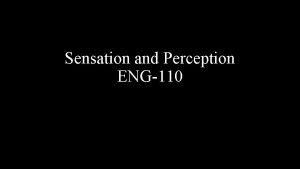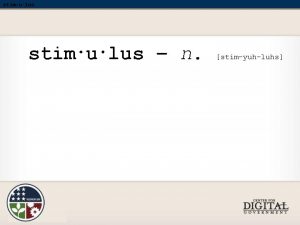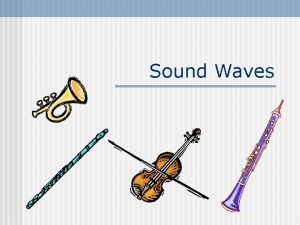Sound and Hearing Nature of the Sound Stimulus





























































- Slides: 61

Sound and Hearing

Nature of the Sound Stimulus “Sound” is the rhythmic compression and decompression of the air around us caused by a vibrating object.

Sound Wave: Amplitude and Frequency (Hz) Sound Pressure is measured in units called Pascals 1 Pascal (Pa) = 1 Newton of force/m 2 1 atmosphere = 100, 000 Pa Human absolute hearing threshold = 0. 00002 Pa = 20 micro. Pa (i. e. , 2 ten billionths of an atmosphere) Frequency measured in cycles/sec = Hertz (Hz) Nominal range of sensitivity: 20 – 20, 000 Hz

The “decibel” (d. B) The decibel is a logarithmic unit used to describe a ratio (i. e. , log (x/y)) In engineering analyses, it is used to normalize “power” measurements to a known reference and then compresses the resulting ratio using a log 10 operation. This format is convenient for engineering analyses involving wide dynamic ranges (when very small and the very large magnitudes must be considered simultaneously). d. B = 10 log(Observed Power / Reference)

d. BSPL The transducers (microphones) on sound level meters measure sound pressure (i. e. , N/m 2 or Pascals). Pressure needs to be converted to power prior to calculation of the decibel equivalent…. i. e. , acoustic power = pressure 2 Finally, we need to agree upon a Reference value. By convention, we use 20 micro. Pa (i. e. , the hearing threshold) Thus: d. B = 10 log (Observed Pressure 2 / 20 micro. Pa 2) However……. .

d. BSPL (continued) Prior to the advent of hand-held calculators and computers (circa 1970), performing a squaring operation was computationally expensive and prone to error. To reduce computational demands, hearing science adopted a somewhat confusing convention in the specification of the d. BSPL unit: d. BSPL = 20 log (Observed Sound Pressure / 20 micro. Pa) +6 d. BSPL = doubling sound pressure +20 d. BSPL = 10 x pressure +3 d. BSIL = doubling acoustic power +10 d. BSIL = 10 x acoustic power

Some Typical Sound Amplitude Values

More about those pesky decibels • JND for sound intensity is about 1 d. BSPL for most of normal range of hearing • What does 0 d. BSPL mean? Hint: 20 log (20 micro. Pa/20 micro. PA) = 0 d. BSPL • If one machine emits 80 d. BSPL then how much sound amplitude would be expected from two machines side-by-side? 2 x 80 = 160 d. BSPL ? ? ? (That’s pretty intense) Convert from d. BSPL back to raw pressure, sum the pressures, then convert sum to d. BSPL 80 d. BSPL anti. Log(80/20) 10, 000 20 log (10, 000+10, 000) = 86 d. BSPL (approx. )

Inverse-Square Law Area of sphere = 4πr 2

A “Better” Sound Amplitude Table? d. BSPL 130 110 95 80 60 50 40 35 25 0 Loud hand clapping at 1 m distance Siren at 10 m distance Hand (circular) power saw at 1 m Very loud expressway traffic at 25 m Lawn mower at 10 m Refrigerator at 1 m Talking; Talk radio level at 2 m Very quiet room fan at low speed at 1 m Normal breathing at 1 m Absolute threshold

Most Sound Stimuli are Complex

Complex Sound = Sum of Sines (Fourier Theorem Revisited) J. B. J. Fourier (1768 -1830) Fourier Sound Applet

Speed of Sound Acoustic energy results from a traveling wave of rhythmic “compression” through a physical medium (e. g. , air; water; steel). It is the “compression” that travels not the medium, per se. The characteristic speed of this travelling wave varies as a function of the medium (elasticity; density). The speed of acoustic energy through the air (aka “sound”) is 331 m/sec (or 742 MPH) at 0 -deg C (Faster at higher temperatures).

Gross Anatomy of the Ear

Flow of Acoustic Energy (The “Impedance Problem”)

The “Impedance Problem” 99. 9% of sound energy in the air is reflected at the air: water boundary (10 log(0. 1/100)) = -30 d. B loss) (1/1000 x) How does the ear compensate for this loss as sound energy is transmitted from the air to the fluid that filled the cochlea? 2 d. B gain via ossicular leverage (1. 6 x) 25 d. B gain via surface area condensation (eardrum stapes) (316 x) ~5 d. B gain at mid-frequencies (3 x) due to pinna and auditory canal resonance

The Cochlea

The Organ of Corti 3000 -3500 Inner Hair Cells (IHC) 12, 000 Outer Hair Cells (OHC)

Photomicrograph: Sensory Hair Cells Three rows of Outer Hair Cells One Row of Inner Hair Cells

Auditory Transduction

Basilar Membrane Modulation Effects upon Sensory Hair Cells Note: K+ ion concentration gradient across sensory hair cells (see pink cavities)

IHC Stereocilia “Tip Links” “tip link” connects gate to adjacent cilia. Shearing motion forces gate to open. Mechanical open-and-close of gate modulates influx of potassium ions (much FASTER than slow chemical cascade in visual transduction). K+ depolarization of IHC triggers release of glutamate at cochlear nerve fiber synapse.

IHC Auditory Transduction

Innervation of 3000 IHCs versus 12, 000 OHCs 30, 000+ fibers in cochlear nerve. Nearly 10: 1 fiberto-IHC innervation ratio. Sparse number of fibers carry info from OHC to brain. Small number of fibers descend from brain to OHCs. Role of OHC’s? Mechanical gain otoacoustic emission

Sound Amplitude Coding (“Divide and Conquer”) Multiple nerve fibers for each IHC. Each nerve fiber tuned to a different 40 d. B “range” of stimulus intensity. Intensity-level multiplexing

Tuning Specificity of Cochlear Nerve Fibers “Broadens” with Increased Intensity Q: Why the broadening and asymmetry? A: Look to the Basilar membrane’s response

Ascending Pathways

Tonotopic Organization of Primary Auditory Cortex (A 1) Also note: Segregation of monaural versus binaural cells is maintained. Binaural cells loosely organized according to spatial location of stimulus source.

Auditory Frequency Coding (What is the neural code for “pitch”? )

Frequency Mechanism versus Place Mechanism Frequency Theory Ernest Rutherford (1871 -1937) Place Theory Georg von Békésy (1899 -1972)

Frequency Theory (Rutherford) • • Basilar membrane analogy to microphone diaphragm Each oscillation yields nerve pulse Problem: Max. neural response approx. 500 Hz Solution: Time division multiplexing (aka “Volley Principle” ) Supported by “cochlear microphonic” (Wever & Bray; but consider Botox results)

von Békésy Place Theory: Focus on Basilar Membrane Dynamics

The Simple Beginnings for von Békésy’s Nobel Prize

Basilar Membrane Response to Pure Tone Stimulus

Von Békésy’s “Place Mechanism” as Biological Fourier Analyzer Basilar Membrane Dynamic Simulation (animation)

Functional Aspects of Hearing

Species-Specific Frequency Range

Human “Earscape”

Minimum Audibility Curve Average detection threshold for 18 -yrolds for 1 KHz tone at sea level is 20 micro. Pa (μPa) Minimum occurs at approx. 3 KHz Binaural intensity thresholds are 3 d. B lower than mono

Clinical Audiogram (d. BHL) d. B-HL (Hearing Level) uses a different reference level for each test frequency. That reference level represents the average threshold (18 yr-olds) demonstrated at that frequency. Hence, a value of 0 d. B-HL means “average” hearing level at the frequency under test.

Normal vs. Noise-Induced Hearing Loss Note “notch” At 4 KHz. Source: http: //mustelid. physiol. ox. ac. uk/drupal/? q=acoustics/clinical_audiograms

Age-related Hearing Loss (Presbycusis) Inevitable or preventable?

Loudness is non-linear

Loudness Stevens’ SONE SCALE of Loudness Perception Perceptual Anchor: 1 sone = loudness of 1 KHz at 40 d. B (40 phons) Find the d. B level that is twice as loud (2 sones) or half as loud (0. 5 sones), etc. and construct a scale. [i. e. , Magnitude Estimation] The psychological magnitude of sound (i. e. , “Loudness”) grows at a slower rate than the physical magnitude of the sound stimulus.

Loudness Using magnitude estimation techniques, S. S. Stevens has quantified this nonlinear relationship as: L = k * P 0. 6 = k * I 0. 3 L=loudness; P=sound pressure (µPa) I=sound intensity (p. W/m 2) Stevens’ Power Law; Linear in log-log plot; slope ≈ exponent log(L)=log(k)+0. 3 log(I) straight line log(L)≈0. 3 log(I) Hence, a log unit increase (10 d. B) of intensity yields 0. 3 log (100. 3 or 2 -fold) increase in loudness. Note: Binaural presentation perceived as approx. 2 x more loud than monaural equivalent.

Sone Scale Landmarks Normal conversation 1 -4 Automobile @ 10 m 4 -16 Vacuum cleaner 16 Major roadway @ 10 m 16 -32 Long-term hearing damage dosage 32+ Jackhammer @ 1 m 64 Brief-exposure hearing damage 256 Pain threshold 676

Pitch = f(Frequency) MEL Scale Semi-Log Plot Reference unit of perceived PITCH: 1000 Hz = 1000 Mels Perceived pitch increases “linearly” with stimulus frequency below 4 KHz; but grows at a much slower rate at 4 KHz and above. Linear Plot

Temporal Summation (< 200 msec) Complements Binaural (i. e. , Spatial) Summation

Equal Loudness Contours Frequency differentiation is flattened at high amplitudes; Speech and music sounds “tinny” at high loudness levels; Remember change in cochlear nerve tuning at higher intensity levels.

Sound Localization

Localization Accuracy vs. Frequency Signature of a dual-mechanism process?

Localization Accuracy vs. Frequency: Low Freq – Interaural Time Difference High Freq – Interaural Intensity Difference ΔT ΔI

Sound Shadowing (Interaural Intensity Difference –IID) High-frequency sound waves are “blocked” by the human head and cast a “shadow” at the far ear (Strong IID cue) Low-frequency sound waves wrap easily around the head and cast little or no sound shadow (Weak IID Cue) ΔI

IID = f(Location, Frequency) ΔI Straight Ahead Right Ear (Perpendicular) Straight Behind

ITD versus Location ΔT Straight Ahead Right Ear (Perpendicular) Straight Behind

Delay Line Theory (How to Build a Cell tuned to delta-T Signals) Delta-T = 200 microsec

“Active” Localization (Continuous Sound Sources)

Straight Ahead vs. Straight Behind Relatively good localization performance despite same IID and ITD levels (i. e. , zeros) Differential sound distortion (“coloration”) introduced by interaction with pinna Modifying shape of pinna causes immediate reduction in localization accuracy (Hoffman, et al. , 1998) Listening through the ears of another yields “ahead” vs. “behind” confusion (chance performance)

Modifying the Pinna Transfer Function (Hoffman, et al. , 1998) Earprints?

Cross-Section of a Head-Related Transfer Function (Spectral Coloration by Head, Torso & Pinnae)

Auditory/Visual Integration Ventriloquism Effect Visual capture of sound localization Mc. Gurk Effect “Compromise” between conflicting sound and visual cues in speech understanding What you hear is what you see
 Associative learning
Associative learning Unit 6 learning ap psychology
Unit 6 learning ap psychology What is relatively permanent in learning
What is relatively permanent in learning Nature and nature's law lay hid in night
Nature and nature's law lay hid in night Chapter 42 hearing speech and vision problems
Chapter 42 hearing speech and vision problems Hearing and equilibrium
Hearing and equilibrium Middle ear
Middle ear Sight hearing taste smell and touch
Sight hearing taste smell and touch Family
Family Proxemics in communication skills
Proxemics in communication skills Hku speech and hearing
Hku speech and hearing Determinace lidské psychiky
Determinace lidské psychiky What is sound
What is sound Section 1 the nature of sound
Section 1 the nature of sound What is a wave
What is a wave Hình ảnh bộ gõ cơ thể búng tay
Hình ảnh bộ gõ cơ thể búng tay Frameset trong html5
Frameset trong html5 Bổ thể
Bổ thể Tỉ lệ cơ thể trẻ em
Tỉ lệ cơ thể trẻ em Gấu đi như thế nào
Gấu đi như thế nào Glasgow thang điểm
Glasgow thang điểm Hát lên người ơi alleluia
Hát lên người ơi alleluia Môn thể thao bắt đầu bằng từ chạy
Môn thể thao bắt đầu bằng từ chạy Thế nào là hệ số cao nhất
Thế nào là hệ số cao nhất Các châu lục và đại dương trên thế giới
Các châu lục và đại dương trên thế giới Công thức tiính động năng
Công thức tiính động năng Trời xanh đây là của chúng ta thể thơ
Trời xanh đây là của chúng ta thể thơ Mật thư anh em như thể tay chân
Mật thư anh em như thể tay chân Phép trừ bù
Phép trừ bù Phản ứng thế ankan
Phản ứng thế ankan Các châu lục và đại dương trên thế giới
Các châu lục và đại dương trên thế giới Thơ thất ngôn tứ tuyệt đường luật
Thơ thất ngôn tứ tuyệt đường luật Quá trình desamine hóa có thể tạo ra
Quá trình desamine hóa có thể tạo ra Một số thể thơ truyền thống
Một số thể thơ truyền thống Cái miệng bé xinh thế chỉ nói điều hay thôi
Cái miệng bé xinh thế chỉ nói điều hay thôi Vẽ hình chiếu vuông góc của vật thể sau
Vẽ hình chiếu vuông góc của vật thể sau Biện pháp chống mỏi cơ
Biện pháp chống mỏi cơ đặc điểm cơ thể của người tối cổ
đặc điểm cơ thể của người tối cổ V. c c
V. c c Vẽ hình chiếu đứng bằng cạnh của vật thể
Vẽ hình chiếu đứng bằng cạnh của vật thể Fecboak
Fecboak Thẻ vin
Thẻ vin đại từ thay thế
đại từ thay thế điện thế nghỉ
điện thế nghỉ Tư thế ngồi viết
Tư thế ngồi viết Diễn thế sinh thái là
Diễn thế sinh thái là Dot
Dot Các số nguyên tố là gì
Các số nguyên tố là gì Tư thế ngồi viết
Tư thế ngồi viết Lời thề hippocrates
Lời thề hippocrates Thiếu nhi thế giới liên hoan
Thiếu nhi thế giới liên hoan ưu thế lai là gì
ưu thế lai là gì Hổ sinh sản vào mùa nào
Hổ sinh sản vào mùa nào Khi nào hổ con có thể sống độc lập
Khi nào hổ con có thể sống độc lập Sơ đồ cơ thể người
Sơ đồ cơ thể người Từ ngữ thể hiện lòng nhân hậu
Từ ngữ thể hiện lòng nhân hậu Thế nào là mạng điện lắp đặt kiểu nổi
Thế nào là mạng điện lắp đặt kiểu nổi Insensitive listening
Insensitive listening Importance of effective listening skills
Importance of effective listening skills Active listening vs hearing
Active listening vs hearing Sensory receptors in vertebrates
Sensory receptors in vertebrates Why does paris fight romeo? *
Why does paris fight romeo? *
